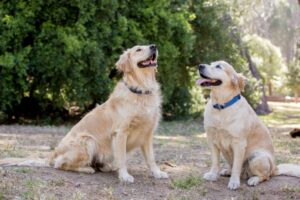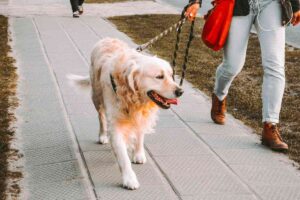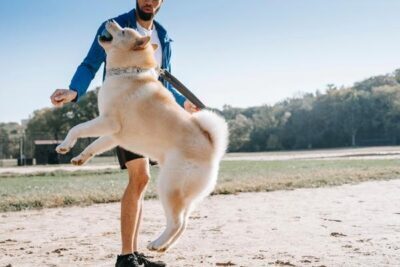Training your dog to ignore other dogs can be helpful in various situations, such as walking on a leash or visiting a dog park. It’s important to start training this behavior early, as teaching an older dog to ignore other dogs can be challenging. However, this article will school you how to train your dog to ignore other dogs.
One way to do this is by teaching your dog to focus on you. Use treats and praises to reward your dog when they make eye contact with you or responds to your commands. Practice this focused training in various environments, including places where other dogs are present.
Also, when you’re out with your dog, try to keep a reasonable distance from other dogs to prevent them from getting too excited or agitated. If your dog does start to get excited or agitated when they see another dog, use a calming command, such as “sit” or “stay,” to redirect their attention back to you.
Use positive reinforcement to reward your dog for ignoring other dogs and following your commands. With consistent training and practice, your dog should eventually learn to ignore other dogs and focus on you, even in the presence of other dogs.
How to train your dog to ignore other dogs
Training your dog to ignore other dogs is a process that requires patience and consistency. Here are some steps you can follow to help your dog learn this behavior:
1. Start by teaching your dog to pay attention to you and focus on you when you give a command. Use treats or toys as rewards to encourage your dog to look at you and follow your commands.
2. Practice in a controlled environment, such as your backyard or a quiet park, where there are fewer distractions. This will help your dog learn to focus on you even when there are other dogs nearby.
3. When you see another dog approaching, give your dog a command, such as “sit” or “stay,” to redirect their attention away from the other dog. Reward your dog for following the command and ignoring the other dog.
4. If your dog continues to get excited or tries to approach the other dog, you can gently use a leash to guide them away from the other dog and back to you.
5. As your dog gets better at ignoring other dogs, you can gradually increase distractions by practicing in busier environments, such as a dog park or on a walk.
Remember to be patient and consistent, and reward your dog for good behavior. It may take some time, but with practice, your dog can learn to ignore other dogs and focus on you.

How do I stop my dog from going crazy around other dogs?
If your dog becomes overly excited or agitated around other dogs, it’s essential to address this behavior, as it can lead to undesirable outcomes such as leash reactivity or aggression. Here are some steps you can take to help stop your dog from going crazy around other dogs:
Socialization
Expose your dog to other dogs at a young age and in a controlled setting to help them learn how to behave around other dogs. This can include taking them to puppy socialization classes or introducing them to other dogs on walks.
Training
Use positive reinforcement training techniques to teach your dog basic obedience commands such as “sit,” “stay,” and “come.” These commands can help you maintain control of your dog’s behavior when it may become overly excited or agitated.
Exercise
Ensure your dog gets enough physical and mental exercise to help them burn off excess energy and reduce anxiety.
Desensitization
If your dog is particularly reactive to other dogs, you may need to work on desensitization training. This involves gradually exposing your dog to other dogs at a distance and increasing the proximity over time as your dog becomes more comfortable.
Management
Suppose your dog struggles to control their behavior around other dogs. In that case, it may be necessary to manage the situation by keeping them on a leash or in a separate area until they can behave calmly.
Please always remember that every dog is different, and what works for one may not work for another. Finding the right approach for your dog may take some trial and error. If you’re having trouble managing your dog’s behavior around other dogs, it may be helpful to seek the guidance of a professional dog trainer or behaviorist.
Will my dog ever ignore other dogs?
It is common for dogs to be attracted to and interested in other dogs, especially when they are out on walks or in social situations. This is because dogs are social animals and naturally want to interact with other dogs.
However, with proper training and socialization, it is possible to teach a dog to ignore other dogs to some extent. This can be useful in situations where it is vital for the dog to focus on its owner or handler or if the other dog is behaving aggressively or unpredictably.
Therefore, to teach a dog to ignore other dogs, it is crucial to start with basic obedience training and socialization to ensure that the dog is well-behaved and able to follow commands. Then, you can work on specific training exercises to teach the dog to focus on you and ignore distractions, such as other dogs.
This may involve using treats or other rewards to reinforce the desired behavior and gradually increase the level of distraction. It is also important to remember that every dog is unique and may respond differently to training, so it may take some time and patience to achieve the desired result.
Why my dog do goes crazy around other dogs?

There could be several reasons your dog may behave aggressively or excitedly around other dogs. Some possible causes could include a lack of socialization, past negative experiences with other dogs, instinctual behavior, fear or anxiety, or proper training and boundaries.
Furthermore, One possible cause for this behavior is a lack of socialization. Dogs not exposed to other dogs at a young age may be more likely to exhibit fear or aggression when they encounter them as adults.
If your dog is not well-socialized as a puppy, it might be more difficult for them to adapt to the presence of other dogs, and they may become overstimulated or anxious in these situations.
Another potential cause of this behavior is past negative experiences with other dogs. If your dog has been attacked or bullied by other dogs in the past, they may become fearful or aggressive when they encounter other dogs as a way to protect themselves.
In some cases, this behavior may be instinctual. Some dogs are bred for specific purposes, such as herding or guarding, and may exhibit behaviors related to these tasks even when they are not working.
Fear or anxiety can also cause dogs to behave aggressively or excitedly around other dogs. If your dog is fearful of other dogs, they may become aggressive as a way to try to protect themselves. Similarly, if your dog is anxious in social situations, it may become overstimulated and behave excitedly or aggressively.
Finally, this behavior could result from a lack of proper training and boundaries. If your dog has not been taught how to behave appropriately around other dogs, it may exhibit undesirable behaviors.
Why is my dog aggressive to other dogs on walks?
We have several reasons a dog may exhibit aggressive behavior towards other dogs while on a walk. Common causes include fear, territoriality, possessiveness, and a lack of socialization. It’s important to understand that aggression is normal behavior for dogs and can be exhibited for various reasons.
One common reason for aggression towards other dogs is fear. If a dog has had negative experiences with other dogs, it may be more likely to become aggressive when encountering other dogs on a walk. This is often because they are trying to protect themselves from perceived threats.
Territoriality and possessiveness are also common reasons for aggression toward other dogs. If a dog feels that another is threatening its territory or possessions, it may become aggressive to protect what they perceive as theirs.
A lack of socialization can also contribute to aggressive behavior toward other dogs. Dogs that have not had the opportunity to interact with a variety of dogs at a young age may be more likely to exhibit aggression when they encounter other dogs as adults.
Suppose your dog is aggressive toward other dogs while on a walk. It’s essential to seek the help of a veterinarian or a professional dog trainer. They can help identify the underlying cause of the aggression and develop a plan to address it.

Why is my dog aggressive to other dogs on leash?
A dog may be aggressive toward other dogs when on a leash for several reasons. Some possible causes include the following:
1. Fear or anxiety: Dogs may become aggressive if they feel threatened or uncomfortable, especially if they are on a leash and unable to escape the situation.
2. Lack of socialization: Dogs that have not been adequately socialized with other dogs may be more likely to exhibit aggressive behavior towards them.
3. Protective behavior: Some dogs may become aggressive towards other dogs if they perceive them as a threat to their owners or themselves.
4. Lack of training: Dogs that have not been trained to behave appropriately around other dogs may be more prone to aggressive behavior.
5. Medical issues: In some cases, aggressive behavior towards other dogs may be due to underlying medical conditions, such as pain or hormonal imbalances.
It’s essential to consult with a veterinarian or a professional dog trainer to determine the cause of your dog’s aggressive behavior and to develop a plan to address it. It’s also important to remember that aggressive behavior can be dangerous and should be addressed as soon as possible.
My dog ignores me when other dogs are around.
It’s not uncommon for dogs to focus more on other dogs nearby. This can be due to various factors, such as socialization, playfulness, or instinctual behaviors.
You can work on building your dog’s focus on you when there are no other dogs around. You can do this through training exercises such as obedience drills, tricks, or other activities that require your dog to pay attention to you. You can also use treats or toys as rewards to reinforce good behavior.
It’s also essential to give your dog plenty of exercise and mental stimulation, as this can help to reduce any pent-up energy or boredom that may be causing them to pay less attention to you.
If your dog continues to ignore you when other dogs are present or if you are concerned about their behavior, it may be helpful to seek the advice of a professional dog trainer or behaviorist. They can assess your dog’s behavior and provide recommendations for addressing any issues.
How to teach dog to greet other dogs calmly.

To teach your dog to greet other dogs calmly, start by practicing greeting behavior at home with your dog using treats and praise to reinforce calm behavior. Gradually introduce your dog to other dogs in controlled settings, such as a dog park or training class, starting with just one other dog at a time and increasing the number of dogs as your dog becomes more comfortable.
Encourage calm behavior by using a calm, assertive tone of voice and body language. Remove your dog from the situation if they become overly excited or displays aggressive behavior.
Finally, regular practice will help your dog become more comfortable and confident when greeting other dogs and make the experience more enjoyable for everyone involved.
How do I train my dog to calm down around other dogs?
Training a dog to calm down around other dogs can be challenging, but it is possible with patience, consistency, and positive reinforcement. Here is a step-by-step guide to help you get started:
Set up a controlled environment
Start by introducing your dog to other dogs in a controlled environment, such as a fenced-in yard or a dog park. This will allow you to gradually expose your dog to other dogs and give you a safe space to work on training.
Reward calm behavior
When your dog is calm and not showing aggressive or anxious behaviors around other dogs, reward this behavior with treats and praise. This will help reinforce the idea that calm behavior is desired and will be rewarded.
Interrupt and redirect
If your dog becomes agitated or aggressive around other dogs, interrupt this behavior by making a loud noise (such as clapping your hands or blowing). This will startle your dog and interrupt the behavior. Then, immediately redirect your dog’s attention to a more desirable activity, such as playing with a toy or receiving treats.
Use a leash
Using a leash can help you maintain control over your dog and prevent them from getting too close to other dogs if they start to get agitated. Keep the leash loose and only use it to intervene if necessary, such as interrupting or redirecting your dog’s behavior.
Practice regularly
Consistency is critical when it comes to training. Make sure to regularly practice these techniques and expose your dog to other dogs in a controlled environment. Your dog will learn to stay calm around other dogs with time and practice.
Always use positive reinforcement and avoid punishing your dog for unwanted behavior. This can create fear and anxiety, making the problem worse. Instead, focus on reinforcing calm and desirable behavior; your dog will learn to be calm around other dogs over time.
How do I stop my dog from lunging when playing?

Here are some tips to help stop your dog from lunging while playing:
1. Use a leash and a harness: Using a leash, and a harness can help you control your dog’s movements and prevent lunging.
2. Train your dog to “sit” and “stay”: Teaching your dog to sit and stay on command can help you control their behavior and prevent lunging.
3. Use positive reinforcement: Reward your dog for good behavior with treats and praise to encourage them to stop lunging.
4. Avoid playing games that encourage lunging: Avoid playing games like tug of war or fetch that can encourage lunging behavior.
5. Interrupt the behavior: If your dog starts to lunge, interrupt the behavior by saying “no” or using vocalization to get their attention.
6. Seek professional help: If your dog’s lunging behavior is severe or you cannot control it, consider using a professional dog trainer or behaviorist.
Why is my dog so obsessed with other dog?

There could be various reasons why your dog is obsessed with other dogs. It could be due to socialization and a desire for companionship, as dogs are social animals and crave interaction with their species.
Also, this might be due to a lack of stimulation or training, which could lead to your dog seeking attention from other dogs to cope with boredom or frustration.
Additionally, certain breeds of dogs may be more prone to socializing with other dogs due to their breed characteristics and history. Ultimately, the specific reason for your dog’s obsession with other dogs may be unique to your dog and may require further investigation and possibly the guidance of a veterinarian or professional dog trainer to address this.
Conclusion
The skill set used on how to train your dog to ignore other dogs is an important skill to have, as it can help prevent unwanted behaviors such as barking, lunging, or growling. To train your dog to ignore other dogs, you can use positive reinforcement techniques, such as treats and praise, to reward your dog for ignoring other dogs.
Practice in controlled settings, such as a training class or a fenced-in area, until your dog becomes more comfortable ignoring other dogs. If your dog displays unwanted behavior, remove them from the situation and try again later.
Use a calm, assertive tone of voice and body language to communicate to your dog that you are in control of the situation. Remember to be patient and consistent and reward your dog for ignoring other dogs. With time and practice, your dog will learn to ignore other dogs and focus on you.


